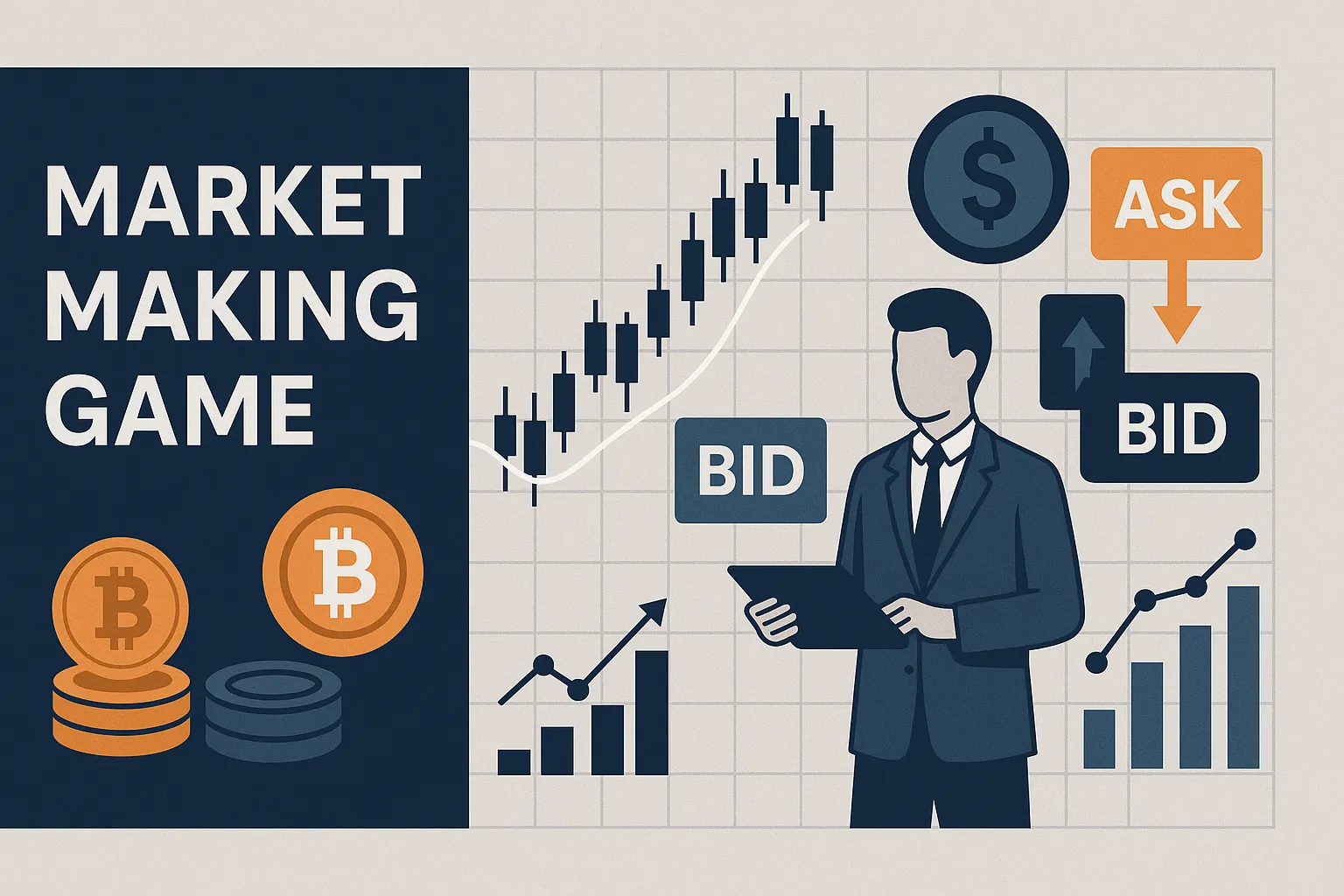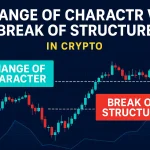The Market Making Game in Crypto Explained
Market Making Game: Strategic Liquidity Dynamics in Cryptocurrency Markets
Market making game is the most sophisticated and lucrative form of cryptocurrency trading. With each iteration, more sophisticated decentralized exchanges and AMM protocols allow market makers to evolve ever-more sophisticated means of harvesting value while providing the vital liquidity the system demands. Based in game theory, it is where mathematical precision combines with strategic placement, an intensely attractive ecosystem wherein protocols, traders, and algorithms all adapt to shifting forces of the market every second.
In this comprehensive tutorial, we’ll see how the market making game is played out in centralized and decentralized cryptocurrency markets.
You will discover how market makers professionals perceive providing liquidity, how protocols designers perceive building incentive schemes, and how you may be able to participate in this complex but rewarding activity.
- Fundamentals of the Market Making Game
- Game Theory Mechanics in Crypto Market Making
- Tokenomic Incentive Structures for Market Makers
- Algorithmic Approaches to Market Making
- Protocol Implementations of Market Making Mechanics
- Risk Management in the Market Making Game
- MEV Protection and Market Making Equilibrium
- Future Trends in the Market Making Game
Fundamentals of the Market Making Game
Fundamentally, market making is a tactical provision of liquidity to accrue revenue on trading commissions, bid-ask spreads, and incentive bonuses. In contrast with conventional financial markets, crypto market making occurs within an environment of hyper-volatility, perpetual 24/7 trading loops, and evolved tokenomic bonuses.
Crypto market makers are themselves to engage a never-ending game in which they:
•Maintain buy and sell orders (bids and asks) on both sides of the book
•Seize buy and sell spread
•Match profit opportunity with inventory risk
•Deal with gas cost, slippage, and impermanent loss
•Outperform other arbitrageurs and market makers
The key performance measures in market making game are:
| Metric | Description | Optimization Target |
|---|---|---|
| Spread Capture | Profits from bid-ask differences | Maximize while maintaining competitive quotes |
| Inventory Risk | Exposure to asset price changes | Minimize through delta-neutral strategies |
| Fill Ratio | Proportion of placed orders executed | Optimize based on strategy (high for passive, lower for aggressive) |
| PnL Volatility | Stability of returns | Minimize through diversification |
Market Making Game vs. Traditional Trading
Compared to directional trading models which are betting on direction of price, the game of market making is that of extracting value from flow of trades while (hopefully) being neutral to the market. This crucial distinction provokes a different risk profile and requires various skill sets, hardware, and capital management strategies.
Game Theory Mechanics in Crypto Market Making
The market making game is an interesting game theory phenomenon to financial markets. Market makers are continuously being pushed to make strategic decisions in an environment where other market makers are maximizing their decisions simultaneously.
Prisoner’s Dilemma in Liquidity Provision
Market makers face a classic prisoner’s dilemma when deciding whether to continue providing liquidity during extreme market conditions:
| Others Provide Liquidity | Others Withdraw Liquidity | |
|---|---|---|
| Provide Liquidity | Moderate returns, moderate risk | High risk, potential for extreme losses |
| Withdraw Liquidity | Missed opportunity, safe position | Market freeze, protection from losses |
This dynamic often leads to cascading liquidity crises in crypto markets during black swan events, as rational market makers simultaneously withdraw their capital.
Tokenomic Incentive Structures for Market Makers
The game of market making is now significantly different with the introduction of tokenomic incentives meant to reward and retain market makers. The models add ancillary strategic elements to market makers in addition to spread capture.
Fee-Sharing Tokens and Governance
Most decentralized exchanges distribute governance tokens to market makers based on liquidity provision metrics. This offers a dual-yield strategy where market makers optimize:
- Short-term trading fee and spread returns
- Appreciation of governance tokens in the long term
- Rights to vote on protocol parameters with market making profitability impact
Examples of these are the UNI token in Uniswap, which gives voting rights to liquidity providers for fee schedules and protocol updates with direct impacts on market making profitability.
Concentrated Liquidity Strategies
The advent of concentrated liquidity protocols such as Uniswap v3 flipped the market making game on its head with the ability to control ranges of liquidity with precision. It produced an even more sophisticated strategic environment where market makers are required to:
- Rebalance ranges of positions in real-time with price action
- Compute optimal points of concentration in order to capture fees as well as potential
- Manage higher risk of impermanent loss due to concentration
The top market making firms currently use sophisticated algorithms to dynamically rebalance concentrated liquidity positions across multiple price buckets, effectively constructing tailored automated market making curves.
Algorithmic Approaches to Market Making
The crypto market making game is more algorithmic today than ever before, with sophisticated quantitative methods defining professional practice.
High-Frequency Market Making Strategies
Sophisticated market making algorithms adjust parameters such as:
- Quote update frequencies (trading gas costs versus adverse selection)
- Volatility metric-driven dynamic spread rebalancing
- Delta-hedging inventory management
- Cross-exchange arbitrage exposure
These algorithms will generally act across venues in aggregate, stitching together a mesh of aggregated liquidity that pulls out maximum capital efficiency.
ML-Driven Approaches to Market Making
Advanced market makers increasingly use machine learning algorithms that:
- predict short-horizon price action to pre-emptively adjust quotes
- identify toxic flow patterns to prevent adverse selection
- optimize sets of parameters under different market regimes
- patterns of trading to separate informed and uninformed flow
These ML methods give sophisticated market makers considerable leverage in the ongoing battle of strategic positioning.
Protocol Implementations of Market Making Mechanics
DeFi protocols have increasingly utilized market making game mechanics as part of direct implementation into protocol design, creating new forms wherein the separation between protocol and market maker is blurred.
Automated Market Makers and LP Incentives
An MM like Curve, Balancer, and Uniswap possess established liquidity provision infrastructure that efficiently costlessly converts passive market makers from end-users at low costs. They employ:
- Multilevel charges in the pattern of fee structures that may be adjusted based on expected volatility
- Specialized curves depending on asset types (stable, volatile, wrapped)
- Booster with incentives towards more extended lockup of liquidity
RFQ Systems and Professional Market Making
Request-for-quote (RFQ) systems like 1inch Fusion and CoW Protocol have created professional platforms for market makers to competitively bid on order flow. Such platforms typically involve:
- Dutch auction systems for choosing market makers
- Reputation systems based on quote-quality and performance
- Protection against MEV by professional execution channels
These implementations have created a meta-game in which protocols vie with one another to attract the best market makers, who competitively bid to provide the most profitable customer slices.
Risk Management in the Market Making Game
Effective market making game play requires sophisticated risk management techniques that address the unique needs of crypto markets.
Inventory Risk and Hedging Strategies
Inventory risk of holding risky crypto assets is a gigantic issue for market makers. Effective strategies involve:
- neutral positions using perpetual futures hedging
- Cross-venue inventory balancing
- Options-based tail risk hedging
- Dynamic exposure limits by volatility regimes
The most sophisticated market makers maintain near real-time hedging businesses that minimize directional exposure but maximize fee capture.
Smart Contract and Technical Risks
Besides market risks, crypto market makers are also subject to certain technical risks:
| Risk Type | Description | Mitigation Strategy |
|---|---|---|
| Smart Contract Exploits | Vulnerability in protocol code leading to fund loss | Exposure limits, insurance coverage, code audits |
| MEV Extraction | Sandwich attacks and other MEV strategies | Private transaction channels, protective slippage |
| Bridge/Custody Risks | Failures in cross-chain infrastructure | Diversification across custody solutions |
MEV Protection and Market Making Equilibrium
Maximum extractable value (MEV) has become front and center as the game of market making, and it is a nuanced interplay among block producers, market makers, and arbitrageurs.
MEV-Aware Market Making Strategies
Sophisticated market makers now incorporate MEV protection into their core strategies:
- Using private transaction pools as a try to avoid frontrunning
- Using provision of liquidity in a just-in-time manner
- Using sandwich-resistant quoting mechanisms
- Working directly with validators/block builders
The arrival of MEV-boost and associated technologies has ushered in a new era of the game of market making where block space is a commoditized tradable good
Searcher Economics and Market Efficiency
Market maker-MS interaction is an intriguing economy where:
- Price efficiency is provided by searchers through arbitrage
- Spreads are harvested by market makers through liquidity provision
- Value is extracted by block producers through ordering rights
This three-way competitive mechanism finally determines the equilibrium level of market efficiency in DeFi ecosystems.
Future Trends in the Market Making Game
The market making game continues to evolve, with a string of future trends to reshape its future landscape.
Institutional Entry and Professionalization
Legacy finance companies are gradually intruding in the crypto universe for market making, with:
- Institutional-level risk management frameworks
- Advanced quantitative modeling capacity
- Increased buffers of capital to provide liquidity
- Advanced cross-asset hedging methods
This trend is likely to lower retail and smaller market makers’ margins but improve overall market depth and efficiency.
Cross-Chain Market Making Innovations
Liquidity fragmentation across multiple blockchains has introduced new challenges and opportunities for market makers:
- Chain-specific asset deployment arbitrage
- Specialized market making strategies across bridges
- Liquidity concentration on multiple AMM implementations
LayerZero, Axelar, and Wormhole platforms are creating infrastructure upon which more effective cross-chain market making will function.
Zero-Knowledge Proofs and Privacy-Preserving Market Making
Emergence of zero-knowledge proof technology is opening up for novel market making approaches:
- Submission of private ordering with no frontrunning
- Execution that is verifiable with no release of strategy information
- Transparency-preserving fairness-enforcing commitment schemes
These technologies could transform market making as a game by transforming information asymmetries that presently overhang much of its strategic landscape into something new and different.
Conclusion
Market making is probably the most sophisticated and dynamic aspect of cryptocurrency trading. From game theory origins to advanced algorithmic uses, market makers provide essential liquidity while acting in a high-fidelity universe of prospects and threats.
As DeFi networks become increasingly sophisticated and institutions start to enter, the game of market-making will supposedly be more technocratic and efficient, with technical know-how and infrastructure more important competitive forces.
To investors and traders, this perception of these market making forces renders meaning to liquidity levels analysis and market action. To protocol developers and engineers, ongoing innovations in forms of market making cast enlightening light on constructing sound and efficient decentralized market infrastructure. What is the single most significant role played by market makers in crypto markets?
Market makers provide liquidity in crypto markets by maintaining orders both sides of the order book, thus allowing traders to trade with little slippage. Market makers make profits from bid-ask spreads, trading commissions, and also typically tokenomic incentives to encourage liquidity providers.
How does concentrated liquidity positioning change the game of market making?
Concentrated liquidity protocols like Uniswap v3 allow market makers to concentrate capital in specific price ranges, maximizing capital efficiency and fee capture opportunities. Active management is required in greater measure, the risk of impermanent loss is greater, and there is a more intricate strategic environment where market makers must rebalance position ranges continuously in order to price movement.
What is the role of MEV in cryptocurrency market making’s game?
Maximal Extractable Value (MEV) heavily impacts market making with frontrunning risks, sandwich attacks, and other order abuses in trades. Advanced market makers of today include protection against MEV through private transaction pools, just-in-time liquidity provision, sandwich-resistant quoting mechanisms, and even direct cooperation with validators or block builders to ensure good ordering of transactions.
Post created by Robert AI Team




